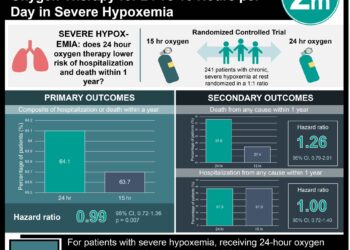Postextubation administration of high-flow oxygen leads to reduced reintubation and respiratory failure
1. The risk of reintubation in the first 72 hours was lower in patients who received high flow oxygen by nasal cannula compared to patients with conventional oxygen therapy, however, time to reintubation was not significantly different between the two groups.
2. Post-extubation respiratory failure was less common in patients given high flow oxygen by nasal cannula as compared to patients treated with conventional oxygen therapy.
Evidence Rating Level: 1 (Excellent)
Study Rundown: Among critically ill, mechanically ventilated patients, there is evidence that increasing the flow of oxygen via nasal cannula after extubation may be associated with improved outcomes. So far, however, the generalizability of prior studies has been limited to populations at high risk for extubation failure. Thus, the aim of this study was to determine whether, in a group of low risk patients, high flow oxygen therapy after extubation would prevent reintubation and improve outcomes as compared to standard oxygen therapy. The oxygen regimens analyzed included high flow therapy, defined as oxygen via nasal cannula starting at 10 L/min and increasing to the upper limit of patient tolerance, and standard therapy, consisting of oxygen flow adjusted to maintain SpO2 >92%.
The study found that high flow nasal cannula oxygen therapy not only decreased the risk of reintubation in critically ill patients at low risk for extubation failure, but also decreased the risk of postextubation respiratory failure. Nonetheless, the study also determined that the time to reintubation was not significantly different between the two groups. The results of the study suggest that high-flow therapy improves oxygenation and reduces causes of respiratory failure by decreasing work of breathing and respiratory muscle fatigue. One limitation of this study its use of a model to predict extubation failure that has not been prospectively validated. In addition, attending physicians were not blinded to the study group. This study’s results may help to affirm oxygen therapy techniques that limit post-extubation reintubation and respiratory infection.
Click to read the study, published today in JAMA
Relevant Reading: Effect of failed extubation on the outcome of mechanical ventilation
In-Depth [randomized controlled trial]: This multicenter randomized control study, which took place at 7 Spanish intensive care units, included 527 critically ill adult patients who met criteria for being low risk for reintubation (based on Acute Physiology and Chronic Health Evaluation II). Enrolled patients were randomized treatment for either high-flow oxygen by nasal cannula (10 L/min, titrated upward in 5 liter/min steps until patient was uncomfortable) or conventional oxygen therapy (continuously through nasal cannula with oxygen flow adjusted to maintain SpO2 >92%). Both groups were treated by the same staff, and assisting physicians were not blinded to the study groups. The primary outcome measured was reintubation within 72 hours, and secondary outcomes included post-extubation respiratory failure, respiratory infection, sepsis, adverse events, and time to reintubation. Reintubation within 72 hours was found to be less common in the high-flow oxygen by nasal cannula group compared to the control group, with the absolute difference 7.2% (95%CI 2.5% to 12.2%, p = 0.004). Nevertheless, time to reintubation between the two groups was not significant, with an absolute difference of -4 hours (95%CI -54 to 46 hours, p = 0.66]. High flow nasal cannula oxygen therapy also decreased the risk of postextubation respiratory failure compared to the conventional group, absolute difference 6.1% (95%CI 0.7% to 11.6%, p = 0.03).
Image: PD
©2016 2 Minute Medicine, Inc. All rights reserved. No works may be reproduced without expressed written consent from 2 Minute Medicine, Inc. Inquire about licensing here. No article should be construed as medical advice and is not intended as such by the authors or by 2 Minute Medicine, Inc.







